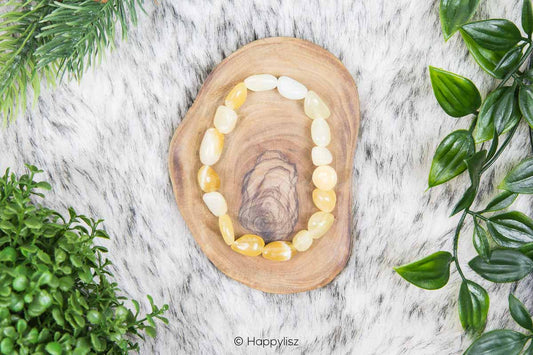Honey Calcite

Motivating • Self-Confidence • Inner Peace • Hope and Courage • Balance • Growth • Analytical Thinking
Appearance
Ranges from golden yellow to brownish yellow in color, is slightly translucent to opaque, and has a matte to glassy luster.
Rarity
Relatively common.
Motivating • Self-Confidence • Inner Peace • Hope and Courage • Balance • Growth • Analytical Thinking
Energetic properties
Honey calcite activates and stimulates growth and development on physical, mental, and spiritual levels. It has a motivating energy and boosts self-confidence. Especially helpful when you need a push or are starting a new project, honey calcite supports initiative and persistence. It also enhances analytical thinking, helps improve concentration, and attracts success. Calcite assists in absorbing negative energy as well. Physically, honey calcite is believed to stimulate the metabolism and immune system and is said to have a positive effect on heart rhythm issues, the skeletal system, and joints.
Suitable for children from about 4 years old.
Formation
Calcite is a mineral composed primarily of calcium carbonate (CaCO₃). Alongside quartz, it is one of the most abundant minerals in the Earth's crust and can be found in sedimentary, metamorphic, and igneous rocks worldwide. It is the main component of limestone, and as such, calcite is present all around us—even in bricks and human bones.
Limestone can form in various ways. One example of organic formation occurs on the sea floor, where thick layers of bones, shells, and remains of small sea creatures accumulate and eventually compress into limestone. Calcite can also form in hot springs, where warm, mineral-rich water rises through cracks in the Earth and cools. The dissolved calcite minerals precipitate onto the walls of these cracks, gradually forming thicker deposits under pressure and time—similar to the limescale that can build up in a kettle.
Calcite appears in many varieties and colors due to the inclusion of different elements. In the case of honey calcite, its warm hue is often the result of iron ions (Fe²⁺).
Etymology
The name calcite is derived from the Latin word calx, meaning 'lime'. The word honey refers to the crystal’s golden color.
Care
Calcite is a form of limestone and generally softer than many other crystals. It’s best not to expose calcite to water for extended periods. Cleaning with a dry cloth is recommended.
Energetic cleansing and recharging can also be done using sage, incense or moonlight.
Because calcite is often porous, it may discolor or become damaged when exposed to (too much) water or harsh chemicals such as cleaning agents or perfumes.
Origin
Can be found in various parts of the world, including the United States, Mexico, Peru, Brazil, Germany, Romania and Pakistan.
Availability
Honey calcite is not particularly rare, but it’s also not the most widely available type of calcite. Its availability depends on the location and the quality of the specimens, but in general, it is less rare than some other calcite varieties.
Properties
Composition: CaCO₃
Hardness: 3
Density: 2.7
Associated with Honey Calcite






-
Calcite Quartet - Rough Crystal Set
Regular price €15,00Regular priceUnit price / per -
Orange Calcite - Crystal Bracelet
Regular price €16,00Regular priceUnit price / per -
Orange Calcite - Raw Chunks
Regular price €4,00Regular priceUnit price / per -
Orange Calcite - Tumbled Stone
Regular price €5,50Regular priceUnit price / per -
Orgonite Hamsa - Orange Calcite & Mookaite
Regular price €35,75Regular priceUnit price / per€55,00Sale price €35,75Sale! -
Orgonite Pyramid - Amazonite & Orange Calcite
Regular price €39,00Regular priceUnit price / per€60,00Sale price €39,00Sale!












